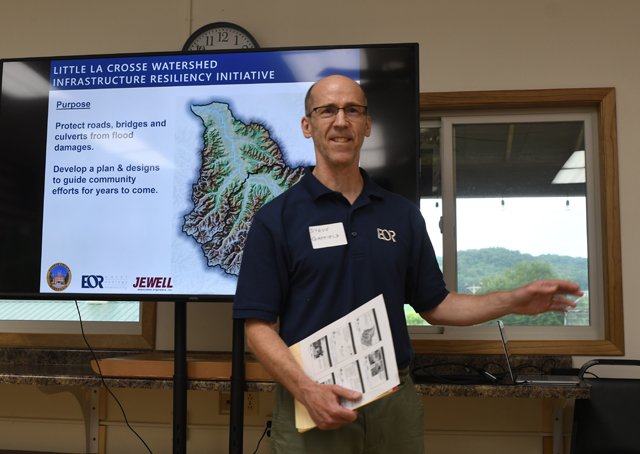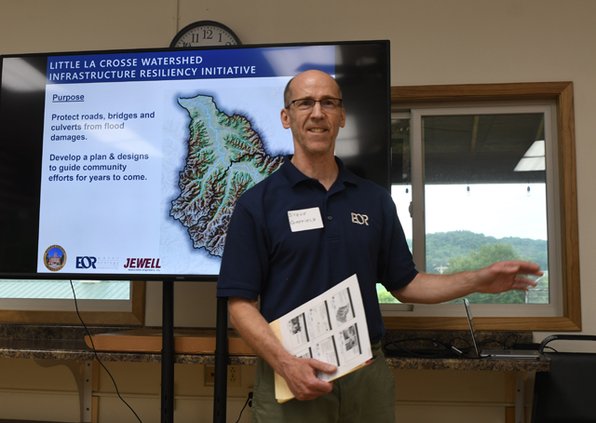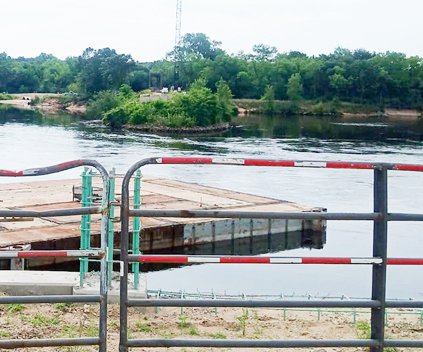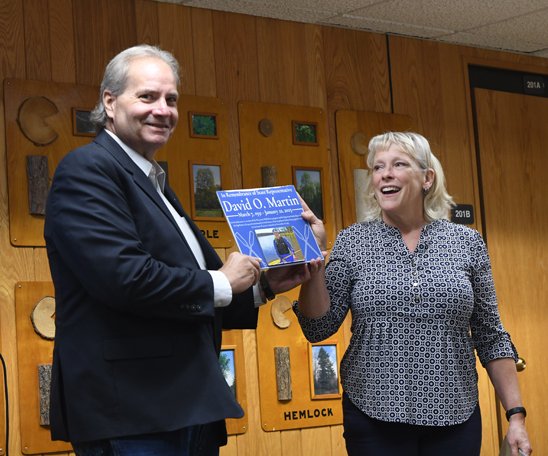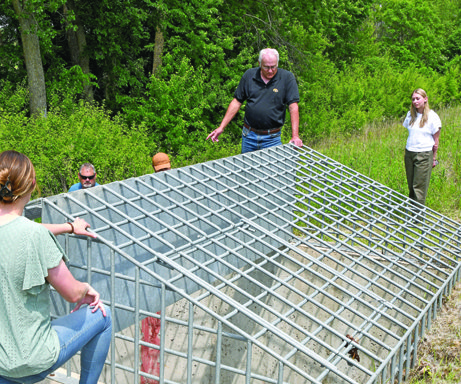Monroe County is at it again, making waves in the area of resilience, this time focused on transportation infrastructure. The county is looking for ways to protect their roads, bridges and culverts from the impacts of flooding.
According to Monroe County Highway Commissioner David Ohnstad, the idea for the project was stimulated by back-to-back flooding events experienced in the county in 2017 and 2018.
“Our infrastructure is designed to handle peak flows from a 100-year, 24-hour rainfall event, but rainfall patterns are changing, and seem to be getting more frequent and intense,” Ohnstad said. “After the 2018 rain event, which was three-to-four times larger than the types of events our infrastructure is designed for, I think we all realized that we can’t build our way out of this.”
Ohnstad said there was talk that the county should increase the design rainfall event for transportation infrastructure to a 200, or 300, or even a 400-year event. He said that theoretically, they could do that, but it would be extraordinarily expensive and impactful to the environment, and “frankly, we wouldn't, we wouldn't get very far.”
He said that rather than trying to out build these events, his department worked with the Land Conservation Department and others to come up with the idea of going back to proven land management techniques designed to mitigate flooding impacts, which also have the benefit of improving the land, improving the habitat for animals, improving the value of the land, keeping the soil and the water where they belong, and not having it running down the road every time it rains.
“After the Federal Highway Administration announced the new Promoting Resilient Operations for Transformative, Efficient, and Cost-saving Transportation (PROTECT) grant, I began to discuss our challenges with Land Conservation Director, Bob Micheel,” Ohnstad said. “In August of 2023, we submitted our PROTECT grant application, and in April of 2024, we were notified that we would receive the grant.
In October of 2024, they were notified that the Monroe County project had been selected as a case study for the Volpe Center, which is the research and technical transfer arm of the Office of the Secretary of Transportation for the United States Department of Transportation.
“After the Volpe Center notified us our project would be a case study, we’ve been getting calls from all over the nation – from Nashville to Oregon, and everywhere in between – asking for information about what we’re doing,” Ohnstad said. “So, our project has potential to be locally, regionally and nationally significant.”
In that first round of PROTECT grant applications, Ohnstad said that 80 projects in 37 states were awarded, but that Monroe County’s was the only one in Wisconsin. The program has since been put on hold.
On the Volpe Center website, it describes their mission as:
“The U.S. DOT Volpe Center objectively addresses the most complex transportation challenges facing transportation and the nation, with specific emphasis on safety, security, environment, energy, mobility, global competitiveness, and innovation. Our extensive cross-modal partnerships have led to innovative solutions that advance national and global transportation systems.
“We work to anticipate emerging transportation issues and objectively address the nation’s most pressing and complex transportation challenges, particularly those that can be solved with an intermodal, systems perspective.
“Through a vibrant culture of thought leadership and meaningful engagement in professional and technical organizations, our team of experts anticipates and addresses challenges, collaborates to drive innovation, and develops solutions that advance the national and global transportation systems.”
Ohnstad said that after the PROTECT Grant contract was executed in November of 2024, the county worked with townships in the county to develop and distribute a ‘request for proposals’ for the project.
The contractors
The nationally recognized firm, Emmons & Olivier Resources (EOR), was selected to lead the study and design project, and they have brought in the Jewell Engineering Firm to assist them. EOR has offices in Minnesota and Madison, Wisconsin.
EOR’s website says they are “a water resource-based engineering and environmental consulting firm that specializes in water resources engineering, watershed planning, and modeling; environmental compliance, biological surveying and restoration; and sustainable site design, planning and landscape architecture.”
Steve Gaffield, EOR Wisconsin Office Lead, Alexander Furneaux, EOR Environmental Planner, and Robert Hanold, Jewell Associates Engineering Vice President and Senior Project Manager, attended the Tuesday, June 24 PROTECT Grant Project Kickoff Meeting at the Leon Community Town Hall.
“Back when I had hair, I spent a lot of time in Monroe County, especially just over the ridge in the Kickapoo Watershed, as a university student. So, I have a lot of fond memories of this area,” Gaffield told the almost 50 citizens present. “My colleague Alex Fernaux is also here, and he is a watershed planner with EOR. Robert Hanold with Jewell Associates Engineering, based at Spring Green, is also here. We've worked together on many projects in the last 10 years.”
Hanold was “boots on the ground” in the 2017 and 2018 flooding events, and grew up outside of Cashton.
“I saw the damages out here in those events, and know about all the damage to private property, not only the public infrastructure,” Hanold said. “So, I'm excited that you're here. I'm excited to talk to you people in this watershed about the damages and get to know a little bit how it affected you personally.”
Gaffield said that his team is here for two years to help with this project, and that their role is to give the community and county a boost, and some advice and some ideas. But, he emphasized that, “this is your project and your watershed in your home, and our most important mission tonight is to listen to what information and ideas you have.”
The project
Generally the ‘study and design project’ is intended to help the county and townships work toward flood resiliency solutions. This will come about through:
• Hydrological evaluation: develop an updated hydrologic model with current and future rainfall to assess effectiveness of proposed solutions
• Hydraulics, structures and related concept solutions: develop a list of conceptual solutions to prevent and mitigate flood issues, including updated flood mapping, an inventory of the conditions of structures such as bridges and culverts, and conducting a cost-benefit analysis of conceptual solutions and projects improving flood resiliency
• Roadside conveyance, energy dissipation, and related concept solutions: develop a list of conceptual solutions to reduce water conveyed to roads, and its energy – evaluate impacts to critical locations in the road network, and conduct a cost-benefit analysis of conceptual solutions and projects specific to preventing roadway damage
• Resiliency improvement plan: summarize watershed challenges and solutions
• Preliminary designs: develop preliminary designs for approximately six projects, which can be developed into final designs in the future when specific sites become available
• Stakeholder engagement: gather feedback on flooding challenges, and potential solutions.
The timeline for the study, expected to ensue in the Little La Crosse River Watershed, and its 12 sub-basins, over the course of two years is as follows:
• Hydrological Evaluation: June-August 2025
• Hydraulic Evaluations: June 2025-May 2026
• Conveyance Assessment and Concept Solutions: August 2025-June 2026
• Resiliency Improvement Plan: July-November 2026
• Preliminary Designs: December 2026-July 2027
• Stakeholder Engagement: June 2025-July 2027.
Project outcomes include:
• Culvert and bridge upsizing
• Slope stabilization
• Overflow area stabilization
• Reducing flow velocity
• Water and sediment control basins
• Floodplain and watershed restoration
• Prairie strips
• Native vegetations
• Terraces
• Cover crops.
“I’ll give you the Reader's Digest version of the two-year project, wrapping up in summer of 2027,” Gaffield told the group. “The first year, you can think of as a study of the key damage areas. How does the water flow on the watershed in different areas? What are some potential solutions, both traditional engineering approaches and green watershed approaches?
“The second year, will be developing a resiliency improvement plan for what types of solutions make the most sense in different parts of the watershed, and developing some preliminary designs that the county and communities can then use going forward, as you have funding available, with landowners that are interested in implementing a project.”
Land Conservation
Ohnstad, the Monroe County Highway Commissioner, provided an introduction for Monroe County Land Conservation Director Bob Micheel.
“This is a true partnership with Land Conservation,” Ohnstad explained. “Our jurisdiction is, as you can well imagine, for the Highway Department, 33 feet from the center line of most highways. However, the impacts to that 33-feet-wide road easement start far, far beyond that. Bob has capably managed the Land Conservation Department for years, where they go out and do the same the exact type of thing that we're going to be trying to implement as part of this project. The difference is, with this project, the focus is reducing the impacts to our bridges and structures, and other highway infrastructure.”
Micheel introduced his staff present at the meeting, and explained what the value of the project would be.
“So, congratulations to the Little La Crosse River Watershed. You have the most unique project, probably, in the United States,” Micheel observed. “I know Dave has fielded calls from other parts of the country looking at what we're doing, and that's why they're studying this.
“It is not new to the world of land conservation,” Micheel noted. “We deal with watershed work. That's where we spend most of our time. What's unique is the Highway Department is going beyond the right of way and looking at the watershed. We're looking for natural solutions, which is the Land Conservation Department working with landowners. And so, why you're here tonight is to kick this off, which is pretty exciting.”
Micheel observed that residents of the Little La Crosse River Watershed have been very proactive over the years in responding to flooding. He said his department had helped to implement a lot of projects, such as:
• Farmland Preservation and Agricultural Enterprise Areas
• stream restoration projects and fishing easements
• assessments on all the town roads, looking at the crossings
• implementing flood monitoring stations in vulnerable watersheds
• home buyouts of properties in the floodplain, returning the land to green space
• formation of the Friends of the Little La Crosse River watershed group.
“Being proactive is kind of the nature of this watershed,” Micheel said. “The flood-monitoring stations were lighting up like Christmas trees over the last few days, and that's our one way of providing information for the National Weather Service to keep people aware of what's going on and get the warnings up there.”
Micheel was enthusiastic about the new watershed council.
“Their mission is to unite communities to protect shared waters through education, restoration and collaborative action in the Little La Crosse Watershed for the benefit of present and future generations,” Micheel shared. “How spot on is that?”
